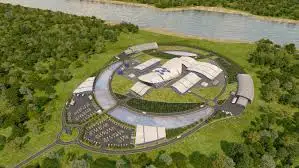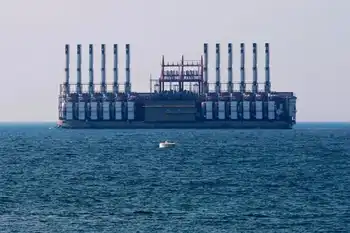Local engineers explore possibility of harnessing tides: Tacoma Narrows is 1 of 7 locations studied in the nation
BELLINGHAM, WASHINGTON - The power of swift water moving through the deep, narrow passages of Puget Sound may be as natural and reliable as the rising moon, but harnessing that power is more complicated.
Although the technology is in its infancy, scientists and engineers at Devine Tarbell & Associates Inc. in Bellingham are helping tidal power pioneers make it viable by navigating the regulatory maze and mapping out its environmental impacts.
Paul Szewczykowski, Devine Tarbell's northwest environmental services manager, said tidal power could be a valuable component of commercial power supply.
"The future is coming," Szewczykowski said. "The whole region's power and electricity needs are not diminishing. It's not a question of if. It's a question of when."
The answer is soon - on a test basis at least. Devine Tarbell is testing and providing consulting services for a pilot project in New York's East River that could be generating power within a couple of months.
The company also contributed to studies that looked at seven promising North American sites, including the Tacoma Narrows, for generating tidal power. Tidal power technology borrows heavily from wind power. Electricity is generated by water turning turbines that resemble windmills.
"It's the same machine modified," said Roger Bedard, ocean energy leader for the Electric Power Research Institute based in Palo Alto, Calif. "The torques are higher (in water), so the root of the blade has to be sturdier."
The nonprofit company studied the North American sites.
The turbine turns when water moves through it in either direction. The greater the water volume and the faster it's moving, the more power it can generate. So in much the same way as a windmill needs to be in a windy place, a tidal turbine needs to be in a place where lots of water moves quickly.
That makes places like the Tacoma Narrows ideal. Relatively large tidal changes are forced through a constricted area. The Narrows' maximum tidal range is about 15 feet, and the peak average speed of the water is 8.7 mph, said Bedard. Along with the technological lessons learned throughout wind power's evolution were lessons about environmental impact.
Large blades spinning in the wind provided emission-free renewable energy, but they can wreak havoc on bird populations depending on where they are installed and how fast they spin.
Devine Tarbell staff will monitor the effects of the East River pilot project for 18 months. Researchers will use sonar systems that resemble high-priced, high-tech fish finders, to monitor any effects on fish behavior. They also will be measuring acoustics, turbulence and water and blade speeds.
That knowledge will inform them if Tacoma Power commits to a test project in the Narrows, part of the ecologically delicate Puget Sound system.
Unlike the East River, the Narrows is home to salmon runs and orcas that governments and citizen groups are striving to protect and increase in population. Bedard, from the nonprofit research group, said the people who are pursuing technology like tidal power have no interest in harming the environment.
"Us renewable (energy) people are environmental people," he said. "Given the proper siting, this is going to be the most benign generation source today."
But assurances of conscientious design and operation won't keep environmental groups from watching the project closely to ensure minimal harm.
"It's worthwhile to explore," said Fred Felleman, northwest director of Ocean Advocates, a national nonprofit environmental organization. "At the same time, we need to be concerned about places like the Narrows that have a restricted waterway for wildlife to pass."
Felleman wondered whether the blade were big enough, and if it would spin fast enough, to cut a whale; if the turbines would create suction that would pull sea life or birds into them; if they would generate noises that would disrupt salmon on their way to spawning grounds. Environmental impacts won't be an issue if investors conclude the project is too costly.
Trey Taylor, co-founder and president of Virginia-based Verdant Power, the company that will be testing its turbines in New York, estimates tidal power will cost 7 to 10 cents per kilowatt hour compared with current electricity production costs of about 3 to 4 cents.
But higher cost of production could be offset by the lower cost of transmission. Tidal power can produce electricity close to the source where it would be used, Szewczykowski said.
And as the price of natural gas rises, the gap in the costs of fossil-fuel-based power and renewable power will shrink, said Roger Garratt, director of resource acquisition for Puget Sound Energy.
"It's very important to get away from fossil fuel and (develop) a diversified portfolio," Garratt said. "We need to create a hedge against high gas prices."
Emissions from coal- and gas-power generation have a high environmental cost, too, he said.
Ted Beatty, principal engineer at Tacoma Power and project manager for the Narrows project, said costs are a major concern, and he's not sure a utility is the right entity to take that on.
"We're hoping to find some partners to help fund the project," he said.
Beatty said that if Tacoma Power does decide to pursue tidal power for commercial sale, the permit process could take five to 10 years. That's because so many agencies would need to approve it.
But Szewczykowski said it's his job to figure out how to streamline the process, and the benefits could be worth it.
"There are not like a million sites where you can do this kind of thing, and the potential payoff is large," he said. "I realize a utility isn't necessarily in the risk game, but they do need to look at alternatives. This is just one that many other municipalities wouldn't have."
Related News

Data Center Boom Poses a Power Challenge for U.S. Utilities
WASHINGTON - U.S. electric utilities are facing a significant new challenge as the explosive growth of data centers puts unprecedented strain on power grids across the nation. According to a new report from Reuters, data centers' power demands are expected to increase dramatically over the next few years, raising concerns about grid reliability and potential increases in electricity costs for businesses and consumers.
What's Driving the Data Center Surge?
The explosion in data centers is being fueled by several factors:
- Cloud Computing: The rise of cloud computing services, where businesses and individuals store and process data on…




